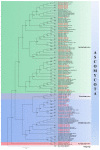Endophytic Fungi Associated with Aquilaria sinensis (Agarwood) from China Show Antagonism against Bacterial and Fungal Pathogens
- PMID: 36422018
- PMCID: PMC9697865
- DOI: 10.3390/jof8111197
Endophytic Fungi Associated with Aquilaria sinensis (Agarwood) from China Show Antagonism against Bacterial and Fungal Pathogens
Abstract
Agarwood is the most expensive non-construction wood product in the world. As a therapeutic agent, agarwood can cure some diseases, but few studies have been carried out on the antagonistic abilities of endophytic fungi associated with agarwood. Agarwood is mainly found in the genus Aquiaria. The objectives of this study are to understand the antimicrobial activities and their potential as biocontrol agents of the endophytic fungi of Aquilaria sinensis. First, fresh samples of A. sinensis were collected from Yunnan and Guangdong Provinces in 2020-2021, and the endophytic fungi were isolated and identified to genus level based on the phylogenetic analyses of the Internal Transcribed Spacer (ITS) region. In this bioassay, 47 endophytic strains were selected to check their bioactivities against three bacterial pathogens viz. Erwinia amylovora, Pseudomonas syringae, and Salmonella enterica; and three fungal pathogens viz. Alternaria alternata, Botrytis cinerea, and Penicillium digitatum. The antibiosis test was carried out by the dual culture assay (10 days), and among the 47 strains selected, 40 strains belong to 18 genera viz. Alternaria, Annulohypoxylon, Aspergillus, Botryosphaeria, Colletotrichum, Corynespora, Curvularia, Daldinia, Diaporthe, Fusarium, Lasiodiplodia, Neofusicoccum, Neopestalotiopsis, Nigrospora, Paracamarosporium, Pseudopithomyces, Trichoderma, Trichosporon and one strain belongs to Xylariaceae had antimicrobial activities. In particular, Lasiodiplodia sp. (YNA-D3) showed the inhibition of all the bacterial and fungal pathogens with a significant inhibition rate. In addition, the strains viz; Curvularia sp. (GDA-3A9), Diaporthe sp. (GDA-2A1), Lasiodiplodia sp. (YNA-D3), Neofusicoccum sp. (YNA-1C3), Nigrospora sp. (GDA-4C1), and Trichoderma sp. (YNA-1C1) showed significant antimicrobial activities and are considered worthy of further studies to identify individual fungal species and their bioactive compounds. This study enriches the diversity of endophytic fungi associated with agarwood, and their potential antagonistic effects against bacterial and fungal pathogens.
Keywords: Lasiodiplodia; agarwood; antibacterial activities; antifungal activities; antimicrobial activities.
Conflict of interest statement
The authors declare no conflict of interest.
Figures




References
-
- The IUCN Red List of Threatened Species Version 2017-3. [(accessed on 10 October 2022)]. Available online: www.Iucnredlist.org.
-
- Kalra R., Kaushik N. A review of chemistry, quality and analysis of infected agarwood tree (Aquilaria sp.) Phytochem. Rev. 2017;16:1045–1079. doi: 10.1007/s11101-017-9518-0. - DOI
-
- Azren P.D., Lee S.Y., Emang D., Mohamed R. History and perspectives of induction technology for agarwood production from cultivated Aquilaria in Asia: A review. J. For. Res. 2018;30:1–11. doi: 10.1007/s11676-018-0627-4. - DOI
-
- Lv F.F., Li S.S., Feng J., Liu P.W., Gao Z.H., Yang Y., Xu Y.H., Wei J.H. Hydrogen peroxide burst triggers accumulation of jasmonates and salicylic acid inducing sesquiterpene biosynthesis in wounded Aquilaria sinesis. J. Plant Physiol. 2019;234–235:167–175. doi: 10.1016/j.jplph.2019.02.006. - DOI - PubMed
Grants and funding
LinkOut - more resources
Full Text Sources
Research Materials

